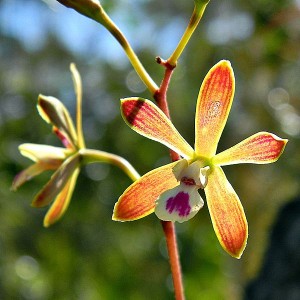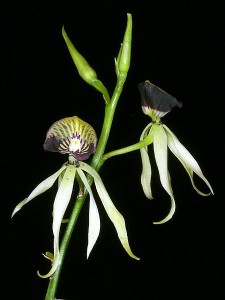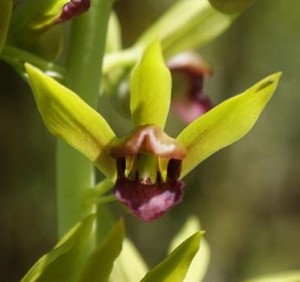Orchids of the Southernmost Point
Posted in The Orchid Show on February 27 2014, by Sonia Uyterhoeven
Sonia Uyterhoeven is the NYBG’s Gardener for Public Education.

Our annual Orchid Show begins this weekend, carrying us off to the warmth and greenery of Key West. I myself have eaten hearts of palm in Key West, toured Ernest Hemingway’s home, and gone swimming and sunbathing, but I never took the time to stop and admire the island’s orchids. On the key, the Audubon House and Tropical Gardens combine history and nature for the avid naturalist, showcasing a one-acre garden full of native and exotic orchids.
Florida boasts a large and diverse population of orchids owing to its climate, which ranges from subtropical in the north to tropical in the south. These variations support temperate and tropical orchids, respectively. Many epiphytic orchids that colonize the southern portion of the state, including Key West, are indigenous to the Caribbean and southern tropical regions.
Among these southern epiphytic species you’ll find the Florida butterfly orchid (Encyclia tampensis). While this epiphytic orchid can be seen growing on bald cypress, palms, and pines, it is most commonly found on southern live oaks. And, in spite of its common name, it’s actually pollinated by bees—not butterflies.
The common name makes more sense when you see an established clump attached to the side of an oak in person. The panicle-like spray of flowers extends from the wiry stems, creating the appearance of a colony of butterflies in flight. The light, lemon-honey fragrance isn’t bad, either.

For another flower rich with personality that can be found throughout the Keys and southern Florida, look no further than the clamshell orchid (Prosthechea cochleata var. triandra) syn. (Encyclia cochleata). Most often found in southern cypress swamps, it has a lip that resembles a clamshell and petals and sepals that dangle like the arms of a deep sea cephalopod. In fact, one of its unofficial common names is the “octopus orchid.”
The cigar orchid (Cyrtopodium punctatum) earns its name from its cigar-shaped pseudobulb (a thick, bulb-like stem used for water storage) wrapped in a papery sheath. It has a preference for growing in impressively large clumps on cypress trees in swamps and the Everglades. And one look at its panicle flower spikes proves this orchid is not for the timid—they can extend up to three feet. The stems are covered with small, one-inch flowers in fiery colors of red, orange, and yellow, each one emitting a pleasant floral fragrance.
If large orchids are your thing, keep an eye out for the wild coco (Eulophia alta) during your next trip to southern Florida. This tall, terrestrial orchid grows by the roadside and in damp meadows, with flower spikes that can reach up to four feet tall. Each spike is smothered with 20 to 30 two-inch flowers that display a pink lip and greenish-brown sepals.

This orchid was once common, but due to the spraying of herbicides along roadsides it is now much harder to find. Many of these orchids are becoming endangered, and an appreciation of their beauty and value is a step in the right direction toward maintaining healthy wild populations.
For your own glimpse into the bright tropical world of these seductive flowers, join us for The Orchid Show: Key West Contemporary, opening Saturday, March 1 and running through April 21.
All photos courtesy of Wikimedia Commons.

